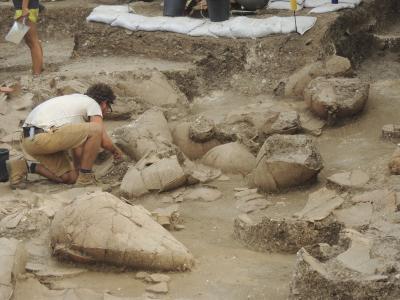Would you drink wine flavored with mint, honey and a dash of psychotropic resins? Ancient Canaanites did more than 3,000 years ago.
Archaeologists have unearthed what may be the oldest, and largest,ancient wine cellar in the Near East, containing forty jars, each of which held up to fifty liters of strong, sweet wine flavored with mint, honey and a dash of psychotropic resins. The cellar was discovered in the ruined palace of a sprawling Canaanite city in northern Israel, called Tel Kabri, far from many of Israel's modern-day wineries, and dates to about 1,700 B.C.
The jar fragments were examined using organic residue analysis. There were molecular traces of tartaric and syringic acid, both key components in wine, as well as compounds suggesting ingredients popular in ancient wine-making, including honey, mint, cinnamon bark, juniper berries and resins. The recipe is similar to medicinal wines used in ancient Egypt for two thousand years.

Ancient wine jugs were unearthed at Tel Kabri. Credit: Eric Cline
"This is a hugely significant discovery — it's a wine cellar that, to our knowledge, is largely unmatched in age and size," says Eric Cline chair of the Department of Classical and Near Eastern Languages and Civilizations of at The George Washington University. Cline and Assaf Yasur-Landau, chair of the Department of Maritime Civilizations at the University of Haifa, co-directed the excavation. Andrew Koh, assistant professor of classical studies at Brandeis University, was an associate director.
They also analyzed the proportions of each diagnostic compound and discovered remarkable consistency between jars.
"This wasn't moonshine that someone was brewing in their basement, eyeballing the measurements," Koh notes. "This wine's recipe was strictly followed in each and every jar."
Important guests drank this wine, notes Yasur-Landau.
"The wine cellar was located near a hall where banquets took place, a place where the Kabri elite and possibly foreign guests consumed goat meat and wine," he says.
At the end of the season, the team discovered two doors leading out of the wine cellar—one to the south, and one to the west. Both probably lead to additional storage rooms. They'll have to wait until 2015 to find out for sure.






Comments